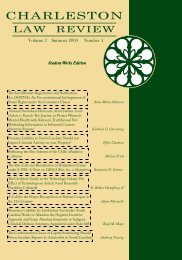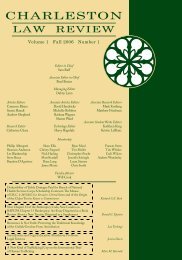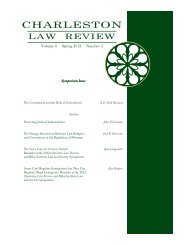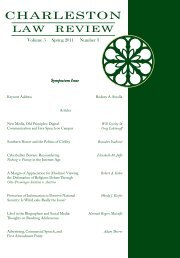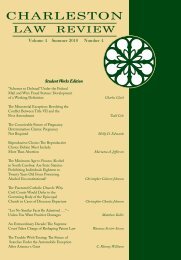Volume 5 Winter 2011 Number 2 - Charleston Law Review
Volume 5 Winter 2011 Number 2 - Charleston Law Review
Volume 5 Winter 2011 Number 2 - Charleston Law Review
You also want an ePaper? Increase the reach of your titles
YUMPU automatically turns print PDFs into web optimized ePapers that Google loves.
SCHULZE FINAL.doc1/20/<strong>2011</strong> 6:14PMCHARLESTON LAW REVIEW [<strong>Volume</strong> 5provide either critical feedback, if the student’s work ethic ormethods are lacking, or positive feedback if the student ismaking progress. 165 In this way, the ASP professor carefullyprovides feedback aimed at ensuring that the students areworking to their optimal potential. 166At the end of the semester, the ASP professor meets with thestudent prior to exams. 167 In this meeting, the professor citesspecific examples of how the student improved over thesemester. 168 The professor might compare the student’s firstpractice essay of the semester to the student’s final essay,showing the vast amount of improvement in the student’sskills. 169 In this way, the ASP provides the student with positiveencouragement and a sense of optimism as she enters theexamination period. 170This type of individual academic counseling demonstratesacademic support’s impact in achieving the “teach students, notsubjects” goal and humanizing the law school environment.First, by working individually with students, academiccounseling mitigates the negative impact of the one-size-fits-alltendency of the rest of the law school environment. For instance,Suffolk <strong>Law</strong> is one of the biggest law schools in the country, andits status as an urban school might result in students feeling theimpact of large class sizes. 171 The ASP provides students withId. If so, the SUASP professor can choose to work directly with the student orto refer him to centralized professional counseling resources. Id. This decisionis fraught with challenges. For instance, if the SUASP professor does not referthe student to professional help, the risk exists that the student’s condition willdeteriorate without treatment. In the alternative, if the SUASP professor doesrefer the student, students can sometimes misperceive this referral as theSUASP professor “washing his hands” of the student. Id. To counteract this,Professor Ramy explicitly tells students that he will continue to meet with thestudent on academic issues, but that the referral is to ensure that the studentreceives resources that might be beyond the expertise of the SUASP professor.See id.165. Id.166. See id.167. Id.168. Id.169. Id.170. See id.171. See id.312



